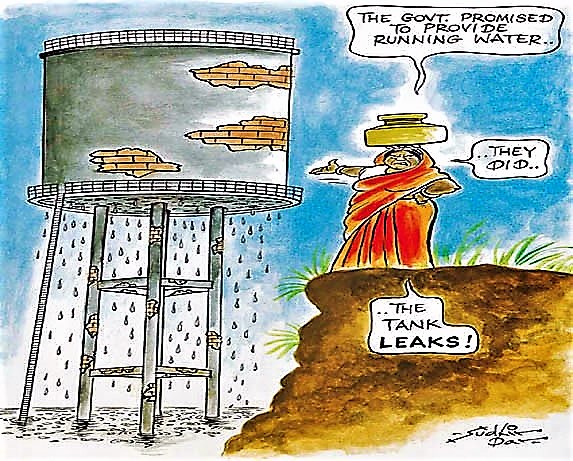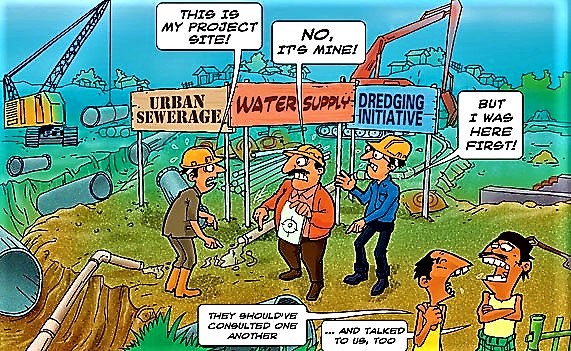Executive Summary
Implementation simply means carrying out the activities described in your work plan. Executing a project in the water and sanitation sector is a very complex mission, as it requires the coordination of a wide range of activities, the overseeing of a team, the management of budget, the communication to the public, among other issues. Independent of whether it is a social project to raise the awareness and promote hygiene or it is a construction project for service delivery, there is a certain process that has to be followed. The following lines will give you an introduction into the implementation of projects in sustainable sanitation and water management, and highlights key aspects that have to be taken into account for a successful implementation
Introduction
Project implementation (or project execution) is the phase where visions and plans become reality. This is the logical conclusion, after evaluating, deciding, visioning, planning, applying for funds and finding the financial resources of a project.

The implementation of projects in sustainable sanitation and water management is complex. It requires the coordination of a wide range of activities, diverse institutional arrangements, and different time frames (DFID 1998). There is not one typical project in water and sanitation, as the actions may vary from the construction of a new infrastructure, to the introduction of new ways of working. Projects in this area cover issues such as: social development, health, environmental sustainability, institutional strengthening, technical implementation, pilot plants, service delivery, social marketing, hygiene promotion, sanitation promotion and capacity building.
It is important to take into account that independently of the nature of the project, implementation takes time, usually more than it is planned, and that many external constraints can appear, which should be considered when initiating the implementation step (i.e. seasonality in availability of community engagement/resources) (NETSSAF 2008).
Objectives of the Implementation Phase
The objectives of the implementation phase can be summarised as follow:
- Putting the action plan into operation (PHILIP et al. 2008).
- Achieving tangible change and improvements (PHILIP et al. 2008).
- Ensuring that new infrastructure, new institutions and new resources are sustainable in every aspect (MORIARTY et al. 2007).
- Ensuring that any unforeseen conflicts that might arise during this stage are resolved (MORIARTY et al. 2007).
- Ensuring transparency with regard to finances (MORIARTY et al. 2007).
- Ensuring that potential benefits are not captured by elites at the expenses of poorer social groups (MORIARTY et al. 2007).
Before you can implement a project, it is imperative that you create a coherent and high-quality project proposal. We have collected the best tipps in our factsheet here. Read on if you already have an established project and wish to implement it successfully.
How to Get Started

“The basic requirement for starting the implementation process is to have the work plan ready and understood by all the actors involved. Technical and non-technical requirements have to be clearly defined and the financial, technical and institutional frameworks of the specific project have to be prepared considering the local conditions. The working team should identify their strengths and weaknesses (internal forces), opportunities and threats (external forces). The strengths and opportunities are positive forces that should be exploited to efficiently implement a project. The weaknesses and threats are hindrances that can hamper project implementation. The implementers should ensure that they devise means of overcoming them. Another basic requirement is that the financial, material and human resources are fully available for the implementation” (NETSSAF 2008). Other actions need to be taken before work can begin to implement the detailed action plan, including:
- Scheduling activities and identifying potential bottlenecks.
- Communicating with the members of the team and ensuring all the roles and responsibilities are distributed and understood.
- Providing for project management tools to coordinate the process.
- Ensuring that the financial resources are available and distributed accordingly.
Tips for Implementing Successful Projects
(Adapted from PHILIP et al. 2008)
- Field management staff must make time to establish an atmosphere of candour and trust with partners during implementation so that concerns may be raised (and often resolved) informally.
- Realistic long-term planning of finances is key to the implementation of an action plan (see also financing and sources of funding).
- A communication strategy can be used to raise awareness (see PPT) of the positive benefits for the community, as well as explaining that there are necessary trade-offs, such as the introduction of water pricing, which will not please everybody. This will help to further strengthen local ownership of the plan and encourage public participation in the implementation of projects.
- At the end of a planning and implementation cycle, a press release is useful to highlight successful stories and announce the publication of a final document such as a water report (see also media campaigns).
- Expectations among stakeholders and the general public are likely to be high following the participatory approach to the development of the preceding stages of the planning process. It is therefore important that actions are visible and demonstrate tangible results early to build confidence in the process.
Implementation of Engineering Projects and Service Delivery
The detailed design, tendering, and construction of the infrastructure will take place during this step. Depending on the situation and the complexity, the project might be implemented through a formal construction contract or a voluntary community approach.
Formal written contracts are required where external contractors undertake specialist construction or installation work. This work should be awarded through a competitive tender process to ensure value for money (DFID 1998). “Other procurement strategies could be a design and build scheme, and a build, own, operate and transfer conception (BOOT). When formal contracts are used, there is the risk of leaving out the social framework and the needs of the users. Therefore, it is necessary to integrate the community during the implementation step, in order to create ownership of the new infrastructure” (NETSSAF 2008).
In community-managed projects, the members of the community are involved in the construction and installation of the new infrastructure through voluntary labour agreements, in-kind contribution, food for work schemes, and self-help programmes where the communities are provided training and resources to carry out the work themselves (NETSSAF 2008). It is generally more cost-effective to use labour from within the community as much as possible. However, there has to be some guarantee of quality and an understanding of the scope of the work. It is useful to have a written agreement between the primary and secondary stakeholders (community and government) defining roles and responsibilities and also agreeing the scope of the works. This will avoid confusion or disagreement later on in the project (DFID 1998).
“It is important to take into account that in urban or peri-urban areas many people already earn a living and would not be prepared to contribute labour to a water supply or sanitation scheme but would rather contribute cash. This situation needs to be assessed at the early stages of a project” (DFID 1998).
A strategy for capacity development should be prepared in order to ensure an effective construction, operation and maintenance work. Training activities will target technicians, masons, users, and other service providers. These activities aim at building the required capacities for the implementation and can be carried out through workshops, specialised training courses, “learning by doing” approach, amongst others.
Whatever method is selected, the construction and installation activities must be carried out under the supervision of experts and engineers. "The level of supervision required will naturally depend on the complexity of the construction work. However, if the design includes any engineering specification, then qualified staff should be available on a full-time basis to oversee construction of the works. The quality of work will suffer if supervision is inadequate because corners may be cut, inferior materials used, and safety compromised" (DFID 1998). The involvement of the designers is also needed during the construction stage, particularly to answer questions and make changes in the design when improvements and adaptations are required.
A practical implementation plan should be prepared by the implementation team to define real time schedule of delivery of services, such as (NETSSAF 2008):
- When the purchase of materials is completed.
- When the excavation is finished.
- When the structures of the buildings are constructed.
- When the commissioning is expected.
Other aspects that have to be taken into account during the construction phase are: sourcing, availability of funds, payment procedures, preparation of contracts, supervision of community labour, division of labour between women and men (see also gender issues, regular meetings with actors, etc.)
“Local practices and skills should be exploited in the design and construction of the infrastructure, for instance, in some countries the quality of concrete work is very poor, while masonry skills are excellent. Similarly, local materials and construction methods should be employed wherever possible. This may not always be possible, for example if rotary drilling in rock is required, but the community should be consulted because they may have their own ideas. In some cases the use of local materials is unacceptable to the partners if it is of a very low quality; it would probably not be cost-effective to purchase local asbestos cement pipes with a design life of five years, if imported ones have a design life of 30 years” (DFID 1998).
Implementation of Social Projects
As mentioned before, social projects are also very common in the water and sanitation field, as they usually target the human factor that is crucial for achieving sustainability of the SSWM measures. These projects are usually related to the change of behaviours and strengthening of capacities by awareness raising (see PPT) campaigns, training activities, institutional set-ups, etc. As these projects cover a wide range of activities that are case-specific, how the implementation will take place will vary from case to case. However, the implementation of a project will always be successful if management strategies and coordination guidelines are clearly defined.
Independent of the type of project to be carried out, a work plan is needed indicating the pursued objectives, the expected results, the activities to be developed, as well as the budget available and timeframe given. Each of the activities has to be assigned to a particular individual, department or organisation that should have proven experience and the capacity to achieve the goals. Local community workers, who can speak the local languages, are the first to integrate in the project, as these types of actions require that the implementers know the culture of the community to gain their trust and achieve a real impact.
It is of primordial importance that the financial resources are readily available at the beginning of the action, so the members of the team have the budget to initiate the activities and cover their own expenses. The management team should look for strategic partnerships with local leaders and spokespersons, giving institutional backup to the actions. Directors and CEOs of the leading organisation should participate in the opening ceremonies or kick-off meeting supporting the local workers, thus facilitating future activities that will be done in the field.
An activity and financial reporting procedure has to be prepared and communicated to the members of the team. It should be clear from the beginning of the action, how all the costs incurred will be reported and reimbursed. It is important to keep procedures as simple as possible, using simple tables and template for reporting costs, field visits, interviews, workshops, meeting minutes, etc.
A controlling strategy has to be developed, in order to monitor the work done on the field. A clearly defined decision making process will set the roles and responsibilities of the members of the team: field worker ->task leaders -> work package leader -> project manager -> coordinator of the project -> steering committee. This ladder will allow for immediate correction of actions and efficient use of (human) resources.
Communication channels should be kept open between the field workers and the management team, making use of mobile phones, SMS, E-mails, etc. It is important to avoid overloading the team with bureaucratic procedures that nobody will follow (like newsletters, long reports, weekly E-mails, etc). Instead, monthly meetings should be planned, bringing the field workers together to report, exchange experiences and learn from each other’s successful and failing stories.
Implementation is the desired step after the carrying out of a participatory planning process, as it represents the realisation of the plans and activities described in the strategy paper.
Guidance Manual on Water Supply and Sanitation Programmes
This manual has been prepared as a tool to help improve DFID's (Department for International Developments, United Kingdom) support for water supply and sanitation projects and programmes in developing countries. Its particular focus is on how DFID assistance can best meet the needs of the urban and rural poor for water supply and sanitation services.
DFID (1998): Guidance Manual on Water Supply and Sanitation Programmes. London: Water, Engineering and Development Centre (WEDC) for the Department for International Development (DFID) URL [Accessed: 09.05.2018]The EMPOWERS Approach to Water Governance: Guidelines, Methods and Tools
The guideline provides information necessary to understand the EMPOWERS approach of water governance and explains in details how to use the approach for planning and implementation of water management and related issues.
MORIARTY, P. BATCHELOR, C. ABD-ALHADI, F. LABAN, P. FAHMY, H. (2007a): INWRDAM The EMPOWERS Approach to Water Governance: Guidelines, Methods and Tools. pdf presentation. Amman, Jordan: Inter-Islamic Network on Water Resources Development and Management (INWRDAM) URL [Accessed: 18.03.2010]Introduction to the NETSSAF Participatory Planning Approach, a tutorial and guideline for sustainable sanitation planning
This presentation describes the NETSSAF participatory planning approach in a brief manner.
BARRETO DILLON, L. BUZIE FRU, C. (2008): Introduction to the NETSSAF Participatory Planning Approach, a tutorial and guideline for sustainable sanitation planning . (= Proceedings of the NETSSAF Final Conference “Pathways towards Sustainable Sanitation in Africa" ). Ouagadougou (Burkina Faso): Network for the development of Sustainable Approaches for large scale implementation of Sanitation in Africa (NETSSAF) URL [Accessed: 18.07.2019] PDFLocal Government and Integrated Water Resources Management (IWRM) Part III: Engaging in IWRM – Practical Steps and Tools for Local Governments
The set of materials entitled “Local Government and Integrated Water Resources Management (IWRM)” aims to assist Local Governments with active participation in IWRM. The materials are primarily targeted at local government officials, but are considered equally useful for individuals and organisations that work with local governments in the management of water resources.
PHILIP, R. ANTON, B. BONJEAN, M. BROMLEY, J. COX, D. SMITS, S. SULLIVAN, C. A. NIEKERK, K. van CHONGUICA, E. MONGGAE, F. NYAGWAMBO, L. PULE, R. BERRAONDO LOEPEZ, M. (2008): Local Government and Integrated Water Resources Management (IWRM) Part III: Engaging in IWRM – Practical Steps and Tools for Local Governments. Freiburg: ICLEI European Secretariat GmbH URL [Accessed: 17.04.2012]WSP 2000 Cartoon Calendar
WSP 2009 Cartoon Calendar
NETSSAF Participatory Planning-Approach
This is the actual tutorial of the participative planning approach developed by NETSSAF, containing all the steps, sub-steps and case studies. It is freely available on the internet in French and English.
NETSSAF (2008): NETSSAF Participatory Planning-Approach. A tutorial for sustainable sanitation planning. Network for the Development of Sustainable Approaches for Large Scale Implementation of Sanitation in Africa (NETSSAF). [Accessed: 29.03.2010] PDFNETSSAF Participatory Planning-Approach
This is the actual tutorial of the participative planning approach developed by NETSSAF, containing all the steps, sub-steps and case studies. It is freely available on the internet in French and English.
NETSSAF (2008): NETSSAF Participatory Planning-Approach. A tutorial for sustainable sanitation planning. Network for the Development of Sustainable Approaches for Large Scale Implementation of Sanitation in Africa (NETSSAF). [Accessed: 29.03.2010] PDFThe EMPOWERS Approach to Water Governance: Guidelines, Methods and Tools
The guideline provides information necessary to understand the EMPOWERS approach of water governance and explains in details how to use the approach for planning and implementation of water management and related issues.
MORIARTY, P. BATCHELOR, C. ABD-ALHADI, F. LABAN, P. FAHMY, H. (2007a): INWRDAM The EMPOWERS Approach to Water Governance: Guidelines, Methods and Tools. pdf presentation. Amman, Jordan: Inter-Islamic Network on Water Resources Development and Management (INWRDAM) URL [Accessed: 18.03.2010]Local Government and Integrated Water Resources Management (IWRM) Part III: Engaging in IWRM – Practical Steps and Tools for Local Governments
The set of materials entitled “Local Government and Integrated Water Resources Management (IWRM)” aims to assist Local Governments with active participation in IWRM. The materials are primarily targeted at local government officials, but are considered equally useful for individuals and organisations that work with local governments in the management of water resources.
PHILIP, R. ANTON, B. BONJEAN, M. BROMLEY, J. COX, D. SMITS, S. SULLIVAN, C. A. NIEKERK, K. van CHONGUICA, E. MONGGAE, F. NYAGWAMBO, L. PULE, R. BERRAONDO LOEPEZ, M. (2008): Local Government and Integrated Water Resources Management (IWRM) Part III: Engaging in IWRM – Practical Steps and Tools for Local Governments. Freiburg: ICLEI European Secretariat GmbH URL [Accessed: 17.04.2012]

